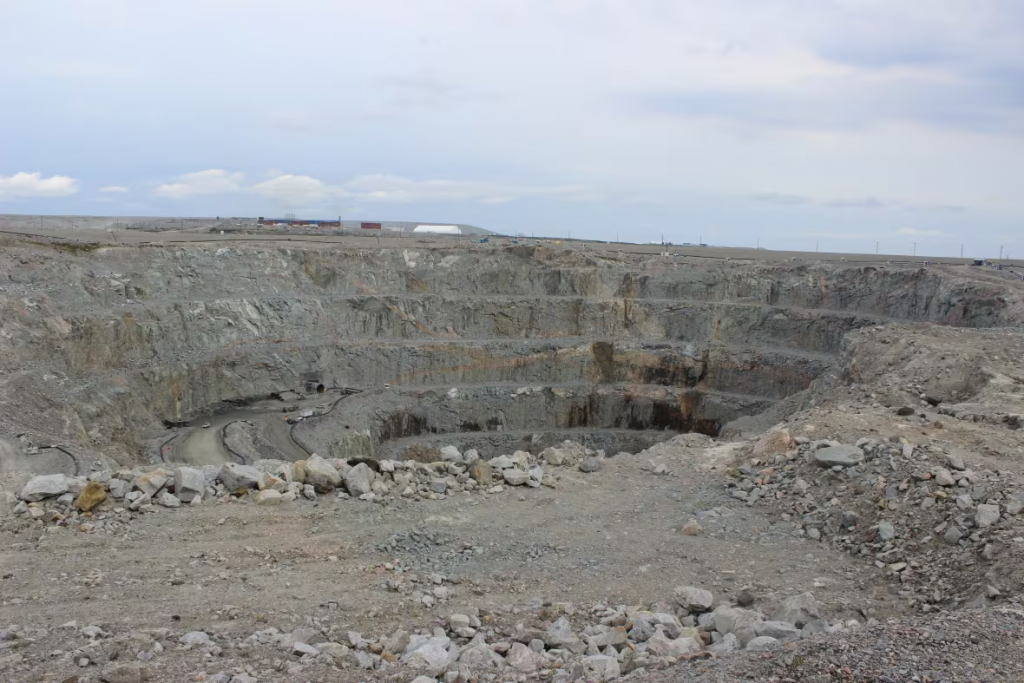Canada News
Low diamond prices raise risk of early closure of N.W.T. mines, experts say

Diavik took media on a tour of its mine site on East Island in Lac de Gras on Aug. 23, 2024. The mine is reporting steep losses from 2024 due to a number of factors including declining diamond prices. (Liny Lamberink/CBC)
By RCI, CBC News
All three N.W.T. diamond mines reported millions of dollars of losses in 2024
All of the N.W.T.’s diamond mines are reporting millions of dollars in losses from last year as they deal with inflation and slumping diamond prices.
With just a short time left in the lifespan of the three mines and more potential economic turbulence ahead, experts believe there is risk the mines could close — and leave the territory with no economic replacement plan — earlier than expected.
Rio Tinto reported its Diavik diamond mine experienced a $127 million loss in 2024, Burgundy reported that Ekati saw a $94.7 million loss, and Gahcho Kué’s minority stake owner Mountain Province reported a $81 million loss.
Graeme Clinton is a Yellowknife economist and the owner of the firm Impact Economics. He also authored the Eyes Wide Open report published last winter, which painted a grim picture of the territory’s economic future once the mines close.
“I don’t think nearly enough is made of the state of the markets which are most important to our economy,” said Clinton.

“These low prices could very well mean an early closure” at all three mines, he said.
Clinton said there’s no indication the mines will be closing early and he doesn’t want to alarm people but he said the low prices are something the public should be aware of because closure could mean the loss of over 1,000 jobs, both directly and indirectly.
He said that remediation also won’t offer nearly as much employment as the operating mines will.
“It’s not like Giant Mine where there’s going to be a 25-year legacy,” he said.
Heather Exner-Pirot is a senior fellow and director of energy, natural resources and environment at the Macdonald-Laurier Institute in Ottawa. Her research focuses on the Arctic and natural resources.
She said her husband works for Gahcho Kué, and that there’s fear among workers about what the slumping prices mean.

Exner-Pirot also said the price of diamonds is important, whether the mines close early or operate until their intended lifespan is over. That’s because if diamond prices remain low, the territory will continue to get fewer royalty payments.
What are the mines saying?
Diavik’s closure is scheduled for the first quarter of 2026, Ekati is expected to operate until 2029 — although there’s been some discussion on its lifespan extending — and Gahcho Kué is expected to operate until about 2030.
Rio Tinto says part of the financial losses in 2024 were impacted by the tragic Fort Smith plane incident, the end of surface-level mining at the A21 pit in 2023, as well as weather and geotechnical issues.
“We are constantly reviewing and managing our costs and expenditures to ensure we run a safe and profitable operation,” reads a statement from Matthew Breen, Diavik’s chief operating officer.
Ariella Calin, a spokesperson for Burgundy, wrote in an email that “2024 was extremely challenging for Ekati due to historic low rough diamond prices with no relief on costs.”

Calin wrote the mine was also impacted by production being lower due to the ramping down of the Sable open pit and preparing for the new Point Lake open pit.
“Even though we are operating in one of the most expensive jurisdictions globally, we are optimistic about the future of Ekati well into the mid-2030s. We will continue to work with our local government, suppliers and communities to help build a sustainable future for the mine for other generations.”
CBC News reached out to Gahcho Kue’s minority owner Mountain Province and majority owner DeBeers. Neither responded by deadline.
Why are the prices so low?
Paul Zimnisky, an independent diamond industry analyst, said the overall diamond market has been challenging for the entire supply chain over the last two years.
Zimnisky said lab-grown diamonds only represented about one per cent of the market 10 years ago, but five years ago it grew to about 10 per cent and now — it’s over 20 per cent.
He said another factor impacting the low prices is that demand for diamonds from China — which was the second largest consumer of diamonds — has gone down by as much as 50 per cent from pre-pandemic levels.
What does the future look like?
Karen Costello, the executive director of the N.W.T. and Nunavut Chamber of Mines, said a big fear for the mines were the tariffs.

Zimnisky said looking forward, the tariffs could complicate supply chains and inflation could impact consumer spending overall. But he said if the U.S. ends up benefiting in the medium-term, it could help with the global consumer diamond demand.
“Overall, I would speculate that a lot of countries will cut or reduce their levies on the U.S. in the coming days and a lot of this will simmer down,” he wrote in a follow-up email.
Zimnisky said the markets have recently been showing some promising signs in consumer spending on diamonds, which could be good news for the territory’s mines.
But even with a bounce back in diamond prices some experts, like Exner-Pirot, say it doesn’t change the territory’s fortune as the mines heads toward closure date with no industry ready to replace them.
“What happens to that capacity when that sector goes, whether it’s next year or five years from now?” she said.





















